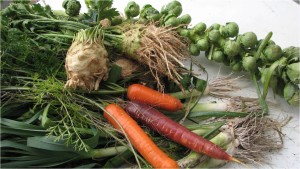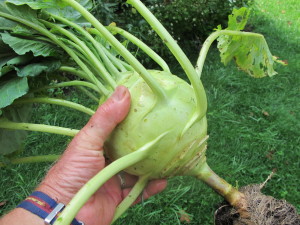Nine Root Crop Stew
Rutabagas? Kohlrabi? Celeriac? What does one do with these lesser known root crops? I make stew. You just need to get past the idea that they are food for “old folks” or “poor people”. There were good reasons that these vegetables – and other root crops – were the backbone of the diet in tough times. These vegetables are easy to grow, store well, and are very tasty.
I recently made a pot of winter stew that used the three veggies mentioned above, along with potatoes, onions, parsnips, garlic, leeks and carrots. Oh my! It was delicious. But first, let’s look at what all these root crops need in order to produce well and fill your root cellar or spare fridge.
All root crops need soil that is essentially rock-free. They need to be able to grow to size without bumping into a boulder, or even a rock the size of a golf ball. So if you have rocky soil, you need to work on it, come spring.
I find a potato fork is good for finding stones. This is a tool similar to a garden fork or spading fork, but the handle is at a right angle to the metal tines. I have one that has been in my family for at least 50 years.
To get stones out of the soil, I sink the tool into the soil and pull it toward me. It acts like a big rake, loosening the soil and dragging stones to the surface. I have seen smaller ones in hardware stores, but the kind I like has tines at least 8-inches long.
I have bought the modern equivalent of my potato fork from a tool company, Howland Tools (www.farmandgardentools.com), that imports them from an Italian maker, Falci. They sell two varieties, the 4-tine hook fork and the 4-tine hook weeding fork. I have the first, but not the second, which has broader tines, like a standard fork. At about $50 each, these tools are well worth the price. Good steel, good beech handles.
What else do root crops need? Most need fluffy, well-drained soil that stays moderately moist all summer. Their requirements vary for the three main minerals, nitrogen (N), phosphorus (P), and potassium (K). Click this link for a summary of what each requires.
What does all that tell you? Root crops are fairly moderate in their needs. Potatoes require yearly addition of a balanced fertilizer. Only garlic does best with fairly dry soil, so planting it in raised beds and adding some extra compost to the soil will help. Add some blood meal to the soil for parsnips as it will provide plenty of nitrogen (13%) but little P or K.
Now the stew, (click here for the recipe) which can be vegetarian or not, depending on your preference. I’m an omnivore, and find that some beef adds flavor and depth to the stew, but you can omit it if you prefer. I use 1 to 2 cups of each of the vegetables, according to my supply and mood.
I start by selecting the vegetables and getting off all soil. Then I peel any that need peeling (potatoes, for example, don’t have to be peeled –the skins may add extra color and vitamins). In a large cast iron enameled pot I start by browning the onions and leeks in olive oil on low heat while I cut up a pound of stew beef into tiny cubes – half inch or so. I add them to the pot and add a little more oil, as the onions tend to suck up the oil fast.
When the meat is browned, I add some liquid to prevent the leeks and onions from burning. Two cups of apple cider is my preference, but either water or broth is fine, too. Then I chop up and add to the mix 3 large tomatoes from my freezer- I freeze them whole. I also add 4 ounces or so of tomato paste I made and froze last summer, and a handful or more of dehydrated Sun Gold cherry tomatoes (optional). If you don’t have frozen tomatoes, use a 28 ounce can of diced tomatoes or sauce.
Next? I cut into small cubes the carrots, celeriac, kohlrabi and rutabagas. These can simmer quite a while without getting mushy. Next the garlic goes in the pot, chopped fine, 2 to 3 cloves. Or more, depending on my whim. Potatoes I cut in bigger pieces and boil separately for 5 minutes, then add to the stew near the end. I want them firm, not mushy.
To achieve the perfect juiciness of the stew, add more liquid at this time. For spicing, I add Herbs de Provence, a tasty mixture of rosemary, thyme, basil and other spices I get at my Coop. A tablespoon is about right for me. And most importantly, I add lots of fresh ginger. I peel and grate a piece nearly the size of my thumb. And although I know people who grow ginger in the Northeast, I’ve tried and not had success, so I buy it.
I garden, in part, because I love to eat –and cook. I don’t mind spending an hour making a meal like this stew, because it will feed me for days. Oh, and by the way, you can make this stew and leave out any of the root crops you don’t have except the carrots, potatoes, onions and ginger, which are essential. Bon appetit!
Read Henry’s twice-weekly blogs about gardening, travel and more at https://dailyuv.com/




